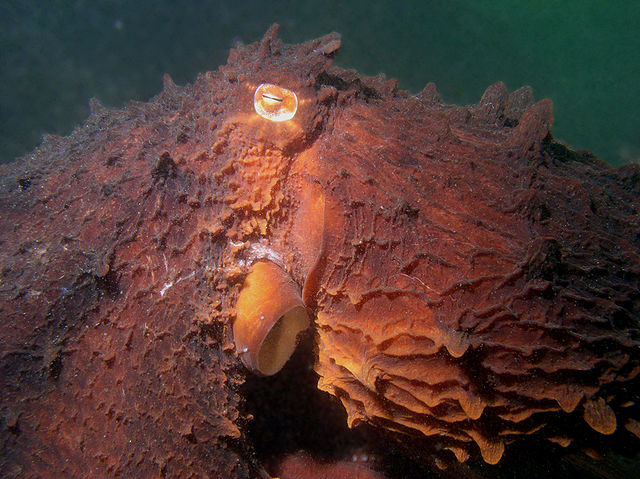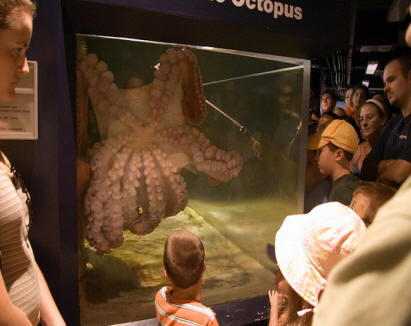Brainy Invertebrate
Intelligence
originates in the brain and nervous system of the Pacific
octopus. Their brains are comprised of 64 lobes and are
protected by cartilaginous craniums. Surprisingly, the brain
increases in both size and cell number throughout the octopus’s
entire life. They also have axial nerve cords down the center of
each arm to carry information to and from the brain. All eight axial nerve
cords are connected by a circular nerve cord at the base of the
mantle.
the brain and nervous system of the Pacific
octopus. Their brains are comprised of 64 lobes and are
protected by cartilaginous craniums. Surprisingly, the brain
increases in both size and cell number throughout the octopus’s
entire life. They also have axial nerve cords down the center of
each arm to carry information to and from the brain. All eight axial nerve
cords are connected by a circular nerve cord at the base of the
mantle.
Three-fifths of the organism’s nerve cells are located in
their arms. Many of these nerve cells are associated with the suckers. Every
single sucker has its own ganglia that connects to the
axial nerve cord. These allow each sucker to report accurate
touch and taste sensations on its own accord. They also each
sucker the ability to move on its own accord with a lot of
dexterity.
In nature, it has been observed that the Pacific
octopus travels away from its den to hunt, and then it returns to
the same den. This proves that the octopuses have spatial
memory. Octopuses are also
able
to utilize a working
memory. They leave their dens and travel one direction the
first day, then a new direction the second day, a new direction
the third, and so on. This hunting style uses the octopus’s
worki ng memory to remember not only how to get home, but also where it has
hunted previously.
ng memory to remember not only how to get home, but also where it has
hunted previously.
In the lab, Pacific octopuses have undergone tests to
study the extent of their intelligence. They have successfully completed mazes, unscrewed jars, and played with
Rubik’s cubes, among numerous other tasks. The octopus in
the video below
is able to quickly and easily open a box containing food. Pacific octopuses can
also been found able to differentiate shapes. This is a greater for the
octopus than humans because octopuses are not born with an automatic shape
analyzer area in their brain. Thus, their ability to do so
the shapes is due to pure learning.
Playing is another intelligent act that has been observed of these
octopuses. One octopus would play with an empty pill bottle. She
would use her siphon to shoot
a stream of water at it. The
bottle would shoot across the aquarium, toward the aquarium’s
filter. Over a short period of time, the filter system would
push the pill bottle back toward the octopus. She would, once
again, shoot the bottle across the aquarium. She did this about twenty
times in a row, for fun. After three to four days she lost the initial
excitement in the task and began to be less interested in the
pill bottle. This shows that octopuses use upper level thinking.
They wonder what an object is, and what they can do with it.
In captivity, Pacific octopuses even show both personalities and
emotion. Some octopuses are shy, others are bold. Some are
aggressive and others are fearful. When hungry, they have been found to invert
their bodies, pointing their
suckers upward, in a bowl shape - like a person’s begging hands.
If the octopus does not receive food, he or she will swim back
while
turning a bright red color. This is believed to be an
invertebrate’s display of the anger emotion.
Back to Interactions
Forward to Fun Facts